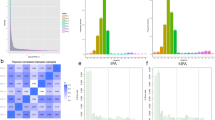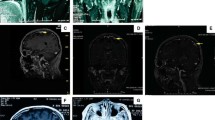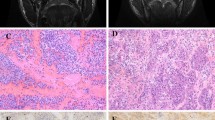Abstract
Objective
Pituitary adenomas (PAs) can adapt an aggressive phenotype by invading adjacent brain structures with rapid cellular proliferation. Previous studies demonstrated that excessive expression of metalloproteases ADAM12 and MMP-14 is instrumental for the active proliferation and invasiveness of PA cells in vitro and of tumors in vivo. However, the mechanisms regulating ADAM12 and MMP-14 expression in PAs remain unclear.
Methods
Target gene prediction and transcriptomic profiling of invasive vs. noninvasive human PA samples were performed to identify miRNA species potentially involved in the regulation of ADAM12 and MMP14. For cellular analyses of miRNA functions, two mouse PA cell lines (AtT20 and TtT/GF) were transfected with miR-149-3p and miR-149-5p, respectively. The effects of miR-149 (3p and 5p) on expression levels of ADAM12 and MMP14 were determined by Western blotting followed by an analysis of proliferation and colony formation assays, scratch migration assays, and invasion assays.
Results
A significant downregulation of miRNA-149 was observed in invasive vs. noninvasive PA (0.32 vs. 0.09, P<0.0001). In AtT-20 and TtT/GF mouse PAs cells, transfection of mimic miRNA-149 (3p and 5p) caused a significantly reduced cell proliferation and matrigel invasion, whilst the effect on cell migration was less pronounced. Both strands of miRNA-149 (3p and 5p) markedly reduced protein levels of ADAM12 and MMP-14 by at least 40% in both cell lines.
Conclusion
This study proved that the invasiveness of PA cells is, at least partly, regulated by miRNA-149-dependent expression of ADAM12 and MMP-14.
Article PDF
Similar content being viewed by others
Avoid common mistakes on your manuscript.
References
Ezzat S, Asa SL, Couldwell WT, et al. The prevalence of pituitary adenomas: a systematic review. Cancer, 2004,101(3):613–619
Asa SL, Ezzat S. The pathogenesis of pituitary tumours. Nat Rev Cancer, 2002,2(11):836–849
Lithgow K, Batra R, Matthews T, et al. Management of endocrine disease: visual morbidity in patients with pituitary adenoma. Eur J Endocrinol, 2019,181(5): R185–R197
Scheithauer BW, Kovacs KT, Laws ER, Jr., et al. Pathology of invasive pituitary tumors with special reference to functional classification. J Neurosurg, 1986,65(6):733–744
Wang J, Voellger B, Benzel J, et al. Metalloproteinases ADAM12 and MMP-14 are associated with cavernous sinus invasion in pituitary adenomas. Int J Cancer, 2016,139(6):1327–1339
Hannen R, Steffani M, Voellger B, et al. Effects of anti-estrogens on cell invasion and survival in pituitary adenoma cells: A systematic study. J Steroid Biochem Mol Biol, 2019,187(3):88–96
Zhang Z, Bartsch JW, Benzel J, et al. Selective estrogen receptor modulators decrease invasiveness in pituitary adenoma cell lines AtT-20 and TtT/GF by affecting expression of MMP-14 and ADAM12. FEBS Open Bio, 2020,10(11):2489–2498
Mikhaleva LM, Davydov AI, Patsap OI, et al. Malignant transformation and associated biomarkers of ovarian endometriosis: a narrative review. Adv Ther, 2020,37(6):2580–2603
Rupaimoole R, Slack FJ. MicroRNA therapeutics: towards a new era for the management of cancer and other diseases. Nat Rev Drug Discov, 2017,16(3):203–222
Hu A, Zhang Y, Zhao X, et al. CBX1 is a direct target of miR-205-5p and contributes to the progression of pituitary tumor. Pharmazie, 2019,74(3):154–156
Yu C, Li J, Sun F, et al. Expression and Clinical Significance of miR-26a and Pleomorphic Adenoma Gene 1 (PLAG1) in Invasive Pituitary Adenoma. Med Sci Monit, 2016,22(5):101–108
Zheng Z, Zhang Y, Zhang Z, et al. Effect of miR-106b on Invasiveness of Pituitary Adenoma via PTEN-PI3K/AKT. Med Sci Monit, 201,23(3):1277–1285
Liao C, Chen W, Fan X, et al. MicroRNA-200c inhibits apoptosis in pituitary adenoma cells by targeting the PTEN/Akt signaling pathway. Oncol Res, 2013,21(3):129–136
Zhang C, Qian Y, Qiao Y, et al. Analysis of whole genome-wide microRNA transcriptome profiling in invasive pituitary adenomas and non-invasive pituitary adenomas. Chin Neurosurg J, 2019,5(1):1–7
Okato A, Arai T, Yamada Y, et al. Dual Strands of PremiR-149 Inhibit Cancer Cell Migration and Invasion through Targeting FOXM1 in Renal Cell Carcinoma. Int J Mol Sci, 2017,18(9):1969
Yang D, Du G, Xu A, et al. Expression of miR-149-3p inhibits proliferation, migration, and invasion of bladder cancer by targeting S100A4. Am J Cancer Res, 2017,7(11):2209–2219
Cao D, Jia Z, You L, et al. 18β-glycyrrhetinic acid suppresses gastric cancer by activation of miR-149-3p-Wnt-1 signaling. Oncotarget, 2016,7(44):71960–71973
Ruan Z, Deng H, Liang M, et al. Downregulation of long non-coding RNA MAFG-AS1 represses tumorigenesis of colorectal cancer cells through the microRNA-149-3p-dependent inhibition of HOXB8. Cancer Cell Int, 2020,20:511
Shen Q, Zhu H, Lei Q, et al. MicroRNA-149-3p inhibits cell proliferation by targeting AKT2 in oral squamous cell carcinoma. Mol Med Rep, 2021,23(3):172
Wang AL, Li Y, Zhao Q, et al. Formononetin inhibits colon carcinoma cell growth and invasion by microRNA-149-mediated EphB3 downregulation and inhibition of PI3K/AKT and STAT3 signaling pathways. Mol Med Rep, 2018,17(6):7721–7729
Hentati-Kallel M, Le Jan S, Bernard P, et al. Histone deacetylases meet microRNA-associated MMP-9 expression regulation in glucocorticoid-sensitive and -resistant cell lines. Int J Oncol, 2017,50(2):717–726
Ghasemloo E, Oryan S, Bigdeli MR, et al. The neuroprotective effect of MicroRNA-149-5p and coenzymeQ 10 by reducing levels of inflammatory cytokines and metalloproteinases following focal brain ischemia in rats. Brain Res Bull, 2021,169(4):205–213
Yan Z, Deng Y, Zou Y, et al. Analysis of regulatory effect of miR-149-5p on Sphingosine-1-phosphate receptor 2 of pericytes and its neuroprotective molecular mechanism after acute cerebral ischemia reperfusion in rats. Bioengineered, 2021,12(1):3348–3357
Pan SJ, Zhan SK, Pei BG, et al. MicroRNA-149 inhibits proliferation and invasion of glioma cells via blockade of AKT1 signaling. Int J Immunopathol Pharmacol, 2012,25(4):871–881
Kodama T, Ikeda E, Okada A, et al. ADAM12 is selectively overexpressed in human glioblastomas and is associated with glioblastoma cell proliferation and shedding of heparin-binding epidermal growth factor. Am J Pathol, 2004,165(5):1743–1753
Lorenz R, Bernhart SH, Höner Zu Siederdissen C, et al. ViennaRNA Package 2.0. Algorithms Mol Biol, 2011,6:26
Acknowledgements
We thank Ulrike Schötz, Department for Radiology, for help with colony formation assays and Kai ZHAO for expert help.
Author information
Authors and Affiliations
Corresponding author
Ethics declarations
The authors declare no conflict of interest.
Authors Jörg W. Bartsch and Ting LEI are members of the Editorial Board for Current Medical Science. The paper was handled by other editors and has undergone rigorous peer review process. Authors Jörg W. Bartsch and Ting LEI were not involved in the journal’s review of, or decisions related to, this manuscript.
Additional information
This research was funded in part by the ERANET PerMed consortium “PerProGlio” (to J.W.B. and A.S.).
Electronic supplementary material
Rights and permissions
Open Access This article is licensed under a Creative Commons Attribution 4.0 International License https://creativecommons.org/licenses/by/4.0/), which permits use, sharing, adaptation, distribution and reproduction in any medium or format, as long as you give appropriate credit to the original author(s) and the source, provide a link to the Creative Commons licence, and indicate if changes were made. The images or other third party material in this article are included in the article’s Creative Commons licence, unless indicated otherwise in a credit line to the material. If material is not included in the article’s Creative Commons licence and your intended use is not permitted by statutory regulation or exceeds the permitted use, you will need to obtain permission directly from the copyright holder. To view a copy of this licence, visit http://creativecommons.org/licenses/by/4.0/.
About this article
Cite this article
Zhang, Z., Schäfer, A., Voellger, B. et al. MicroRNA-149 Regulates Proliferation, Migration, and Invasion of Pituitary Adenoma Cells by Targeting ADAM12 and MMP14. CURR MED SCI 42, 1131–1139 (2022). https://doi.org/10.1007/s11596-022-2676-3
Received:
Accepted:
Published:
Issue Date:
DOI: https://doi.org/10.1007/s11596-022-2676-3




